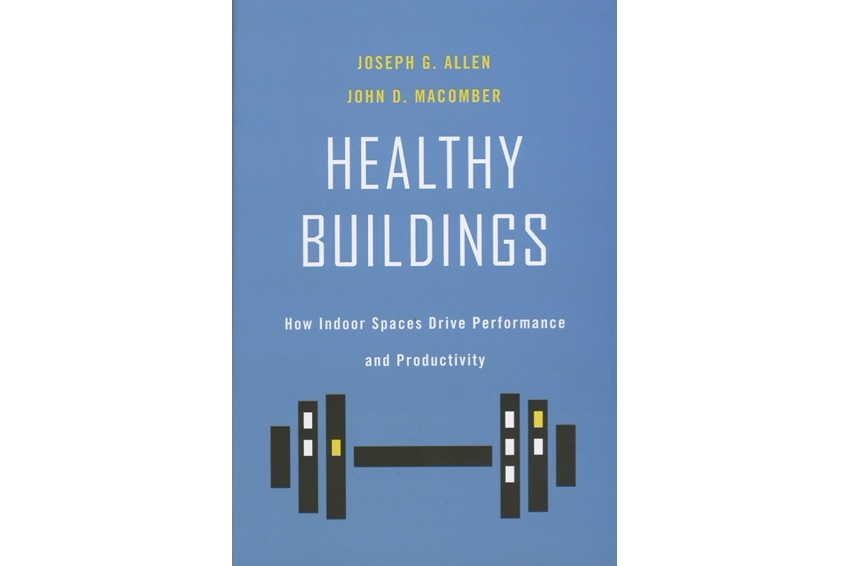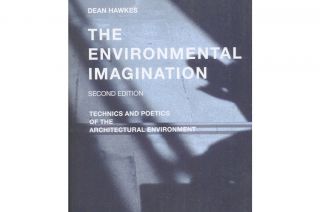
www.buildingsandcities.org/insights/reviews/healthy-buildings-indoor-space-performance-productivity-review.html
Healthy Buildings: How Indoor Spaces Drive Performance and Productivity

Edited by Joseph Allen and John Macomber. Harvard University Press, 2020, ISBN: 9780674237971
Marcella Ucci (UCL Institute for Environmental Design and Engineering) considers how Healthy Buildings offers a call to action for why we need healthy buildings and how they can be delivered.
When considering the book's title and the academic affiliation of its two Harvard-based authors, prospective readers may perhaps expect a scholastic manual or handbook about the topic. In fact, the book is first and foremost a lucid and passionate outline of why now is the time to acknowledge the huge and unrealised potential for buildings to make a positive contribution to the health and performance of their inhabitants, the economy, society and the planet. In this sense, this is a very different and innovative book compared with other similarly themed ones.
This book is also a call to action, where evidence and its underlying science are explained with the goal of revealing its practical and deeper implications for built environment professionals, business leaders, real estate developers and investors, as well as workers and society at large. Accordingly, the book is structured into two sections starting with the 'why' (Part 1: The Case for Healthy Buildings), followed by the 'how' (Part 2: A Healthy Building Strategy). The focus of the discussion and of the evidence/examples are often centred around air quality considerations, although the importance of other factors is addressed in some sections, especially in Part Two where "The 9 Foundations of Healthy Buildings" presents a comprehensive framework for conceptualising and measuring building performance across nine parameters. These include: water quality, noise, thermal health, lighting and views, safety and security, dust and pets, moisture, air quality, and ventilation.
A fundamental concept, which the authors themselves flag up as the one thing to remember, if nothing else, from their book (p. 240) is asking ourselves the question: "Why are we ignoring the 90%?", which is the title of Chapter 3 addressing, primarily with a focus on air quality considerations, the importance of indoor environments where we spend up to 90% of our time. The section is one of the best and clearest explanations I have come across about this fundamental issue: we have become an 'indoor species', spending up to 90% within indoor environments. Yet the impact of these environments on our health and productivity is largely undervalued or misunderstood. Various compelling examples and evidence are provided, ranging from evocative statements ("Americans spend more time inside buildings than some whale species spend underwater", p. 39), to the provocatively titled Table 3.1 "The dirty secret of air pollution" (p. 44). The table demonstrates quite clearly how our 'indoor species' is likely to be exposed to a bigger dose of outdoor air pollution whilst being indoors, compared to the dose whilst outdoors. This Chapter also gives the opportunity to become acquainted, within a meaningful context and through relevant examples, with key scientific concepts such as exposure and risk. These are not widely understood by built environment and real estate professionals, yet a basic understanding of their fundamentals is key so that any risks to health can be minimised, whilst benefits to health/performance maximised.
Another key section in the book is in Chapter 4, where the core argument of the book is outlined, namely that: 1) healthy indoor air equals better health and productivity; 2) the financial gains from this mechanism are sizeable and thus appealing from a business perspective. Crucially, the authors argue that the issue of split or misaligned incentives (e.g. landlord does not directly benefit from health/productivity gains of tenants) can be overcome, because the financial gains are large enough to be shared between stakeholders. Both arguments are demonstrated with examples, some from research published in peer-reviewed papers. They include tables with specific financial estimates and whilst these are in US dollars, the overall implications are clear enough for those who operate in other countries. Besides the potential for financial gain, throughout the book other key drivers for healthy buildings are highlighted, including the important lever of risk management. It is argued that advances in sensing and digital technology mean that building performance is now easier to measure and, most crucially, can be more visible, e.g. via digital platforms and social media. Hence, real estate investors and business leaders would be wise to minimise the reputational and/or litigation risks arising from poorly performing buildings.
The book does address, although perhaps not as comprehensively as other topics, one of the obvious conundrums in this field: shall we sacrifice energy efficiency and low carbon targets in the pursuit of healthy buildings? The authors' position on this matter is clear: the health of our planet and the health of our species are equally important and completely intertwined. An entire chapter (Chapter 10) is dedicated to these issues, also discussing the 'Health co-benefits of Energy-Efficient Buildings' and aiming to "debunk a myth": namely that the goals of 'green' and 'healthy' are in conflict. The discourse in these sections is as persuasive as in other sections within the book, but perhaps missing some of the more specific examples and tables which can convince the most sceptical readers. For instance, the authors argue that calling for greater ventilation rates in buildings is not equivalent to condoning greater energy use, and suggest that, for example, energy-recovery ventilation (i.e. mechanical ventilation with heat recovery) can mitigate most of the higher energy requirements for higher ventilation rates (p. 209). However, I can think of several HVAC engineers who would frown at this logic, especially those operating in countries where ventilation with energy/heat recovery is commonplace and where there is a push for lowering energy demand as much as possible. On the other hand, since the book's main focus is not centred around the synergies or conflicts between energy efficiency and health, a comprehensive debate may be outside its scope.
One of the sections I personally enjoyed the most is Chapter 9, specifically the section "Doing it Wrong: the Mismanagement of "People Businesses"". It is a clearly articulated and at times almost merciless analysis of the flaws of Post Occupancy Evaluation (POE) surveys, and especially of the way results are commonly reported in professional journals and media. The flaws are addressed with reference to well-known research methods basics, which may sound pedantic to some: yet the examples clearly and simply articulate why these basic principles (e.g. representativeness, selection bias etc.) have a practical significance and thus must be considered when designing, analysing and reporting findings from POE surveys. Some of these flaws are then used by the authors to support the importance of alternative ways to measure building performance, specifically Health Performance Indicators (HPI) whose principles are outlined with interesting examples of their significance.
Overall this is a powerful and enjoyable book, which will appeal to those with an interest in business and built environment alike. Evidence and science are presented in an accessible and clear way, interspaced with colloquialism and personal anecdotes (including how one of the authors narrowly missed becoming an FBI agent), making it both a relatable and authoritative read. Perhaps the most enjoyable aspect of the book is the clear sense of conviction and passion for healthy buildings that the authors' words exude.
I can't help but feel for the authors whose book has been published shortly before the COVID-19 pandemic - they might have loved an opportunity to add some reflections on how this is yet another example of how and why healthy buildings matter: an aspect covered for example by Dr Allen in various media outlets. It is harder however to foresee how some of the market mechanisms outlined in the book as a conduit for healthy buildings may or may not be affected by the COVID-19 pandemic and associated economic crisis.
At the time of writing this review, the world is engulfed
with the short and long-term impacts of the COVID-19 epidemic, which has also
shone a bright light on the deep inequalities embedded within our society. For
example, there is much debate on the disproportionate effect of COVID-19 on
ethnic minorities worldwide (Kirby, 2020). Economic hardship resulting from the
pandemic is likely to hit hardest those already in the most disadvantaged
groups. It is hard to imagine how such deep-rooted inequality issues can be
addressed primarily through market-driven mechanisms and without the determined
effort of policy makers and world leaders, hopefully with support from the
public. The book states that "The Healthy Building strategies in this book must
not only benefit the 1 percent" (p. 238). Yet, interestingly the authors
themselves do not seem to address policy makers in their call for action: for
example, policy makers or public health professionals are not explicitly listed
as stakeholders in the Preface. It would have been hard to write a similarly
compelling and easy to read book which appeals to both policy makers and business leaders. I wonder if this
might give us a clue to the next book from the authors?
References
Kirby T., 8 May 2020, Evidence mounts on the disproportionate effect of COVID-19 on ethnic minorities. The Lancet Respiratory Medicine. https://doi.org/10.1016/S2213-2600(20)30228-9
Latest Peer-Reviewed Journal Content
Acceptability of sufficiency consumption policies by Finnish households
E Nuorivaara & S Ahvenharju
Key factors for revitalising heritage buildings through adaptive reuse
É Savoie, J P Sapinski & A-M Laroche
Cooler streets for a cycleable city: assessing policy alignment
C Tang & J Bush
Understanding the embodied carbon credentials of modern methods of construction
R O'Hegarty, A McCarthy, J O'Hagan, T Thanapornpakornsin, S Raffoul & O Kinnane
The changing typology of urban apartment buildings in Aurinkolahti
S Meriläinen & A Tervo
Embodied climate impacts in urban development: a neighbourhood case study
S Sjökvist, N Francart, M Balouktsi & H Birgisdottir
Environmental effects of urban wind energy harvesting: a review
I Tsionas, M laguno-Munitxa & A Stephan
Office environment and employee differences by company health management certification
S Arata, M Sugiuchi, T Ikaga, Y Shiraishi, T Hayashi, S Ando & S Kawakubo
Spatiotemporal evaluation of embodied carbon in urban residential development
I Talvitie, A Amiri & S Junnila
Energy sufficiency in buildings and cities: current research, future directions [editorial]
M Sahakian, T Fawcett & S Darby
Sufficiency, consumption patterns and limits: a survey of French households
J Bouillet & C Grandclément
Health inequalities and indoor environments: research challenges and priorities [editorial]
M Ucci & A Mavrogianni
Operationalising energy sufficiency for low-carbon built environments in urbanising India
A B Lall & G Sethi
Promoting practices of sufficiency: reprogramming resource-intensive material arrangements
T H Christensen, L K Aagaard, A K Juvik, C Samson & K Gram-Hanssen
Culture change in the UK construction industry: an anthropological perspective
I Tellam
Are people willing to share living space? Household preferences in Finland
E Ruokamo, E Kylkilahti, M Lettenmeier & A Toppinen
Towards urban LCA: examining densification alternatives for a residential neighbourhood
M Moisio, E Salmio, T Kaasalainen, S Huuhka, A Räsänen, J Lahdensivu, M Leppänen & P Kuula
A population-level framework to estimate unequal exposure to indoor heat and air pollution
R Cole, C H Simpson, L Ferguson, P Symonds, J Taylor, C Heaviside, P Murage, H L Macintyre, S Hajat, A Mavrogianni & M Davies
Finnish glazed balconies: residents' experience, wellbeing and use
L Jegard, R Castaño-Rosa, S Kilpeläinen & S Pelsmakers
Modelling Nigerian residential dwellings: bottom-up approach and scenario analysis
C C Nwagwu, S Akin & E G Hertwich
Mapping municipal land policies: applications of flexible zoning for densification
V Götze, J-D Gerber & M Jehling
Energy sufficiency and recognition justice: a study of household consumption
A Guilbert
Linking housing, socio-demographic, environmental and mental health data at scale
P Symonds, C H Simpson, G Petrou, L Ferguson, A Mavrogianni & M Davies
Measuring health inequities due to housing characteristics
K Govertsen & M Kane
Provide or prevent? Exploring sufficiency imaginaries within Danish systems of provision
L K Aagaard & T H Christensen
Imagining sufficiency through collective changes as satisfiers
O Moynat & M Sahakian
US urban land-use reform: a strategy for energy sufficiency
Z M Subin, J Lombardi, R Muralidharan, J Korn, J Malik, T Pullen, M Wei & T Hong
Mapping supply chains for energy retrofit
F Wade & Y Han
Operationalising building-related energy sufficiency measures in SMEs
I Fouiteh, J D Cabrera Santelices, A Susini & M K Patel
Promoting neighbourhood sharing: infrastructures of convenience and community
A Huber, H Heinrichs & M Jaeger-Erben
New insights into thermal comfort sufficiency in dwellings
G van Moeseke, D de Grave, A Anciaux, J Sobczak & G Wallenborn
'Rightsize': a housing design game for spatial and energy sufficiency
P Graham, P Nourian, E Warwick & M Gath-Morad
Implementing housing policies for a sufficient lifestyle
M Bagheri, L Roth, L Siebke, C Rohde & H-J Linke
The jobs of climate adaptation
T Denham, L Rickards & O Ajulo
Structural barriers to sufficiency: the contribution of research on elites
M Koch, K Emilsson, J Lee & H Johansson
Disrupting the imaginaries of urban action to deliver just adaptation [editorial]
V Castán-Broto, M Olazabal & G Ziervogel
Nature for resilience reconfigured: global- to-local translation of frames in Africa
K Rochell, H Bulkeley & H Runhaar
How hegemonic discourses of sustainability influence urban climate action
V Castán Broto, L Westman & P Huang
Fabric first: is it still the right approach?
N Eyre, T Fawcett, M Topouzi, G Killip, T Oreszczyn, K Jenkinson & J Rosenow
Social value of the built environment [editorial]
F Samuel & K Watson
Understanding demolition [editorial]
S Huuhka
Data politics in the built environment [editorial]
A Karvonen & T Hargreaves



Latest Commentaries
Decolonising Cities: The Role of Street Naming
During colonialisation, street names were drawn from historical and societal contexts of the colonisers. Street nomenclature deployed by colonial administrators has a role in legitimising historical narratives and decentring local languages, cultures and heritage. Buyana Kareem examines street renaming as an important element of decolonisation.
Integrating Nature into Cities
Increasing vegetation and green and blue spaces in cities can support both climate change mitigation and adaptation goals, while also enhancing biodiversity and ecological health. Maibritt Pedersen Zari (Auckland University of Technology) explains why nature-based solutions (NbS) must be a vital part of urban planning and design.